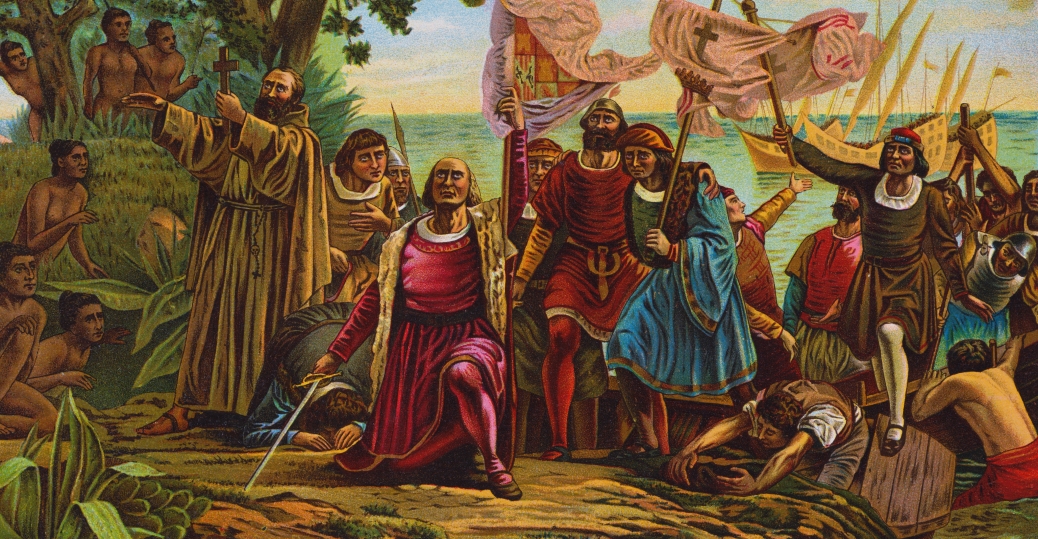Top 15 Facts About Christopher Columbus
Originally published by Alex W on December 2019 and updated by Charity K on August 2022 and Updated by Vanessa R on July 2023
While Christopher Columbus is remembered with pride by Spain, he himself wasn’t Spanish. Columbus was born in Italy but lived in Spain later in his life. Thus, those who assume today that he is from Spain misconceive the truth due to the fact that he lived most of his life there.
This is one of the many details to be learned about the 15th-century pioneer who was Christopher Columbus and whose tale of adventure is known by all to this day. Although, not everyone knows more than the rhyme that says he sailed the ocean blue in 1492. Keep reading to learn 15 new facts about his life and discovery of America.
1. Columbus’ expedition was made possible by the Spanish monarchs.
The main reason why Columbus forms an integral part of Spain’s history is because of Isabella and Ferdinand of Spain, the Catholic King and Queen who commissioned his journeys to the New World and governed his actions.
There were several reasons why the King and Queen wanted to fund Columbus and make the expeditions possible, even though it took two years for him to convince them. For one thing, they wanted to believe the theory that there was an easier way to get to Asia so that they could reap the trade benefits faster and cheaper than Portugal could.
Additionally, the monarchs were set on the exile of Muslims and Jews since they were strongly Catholic. Therefore, the religious factor was a large one. They hoped to convert the people of the New World to Christianity.
Nonetheless, it was presumably the alleged abundance of gold that Columbus was expecting to sail into that really motivated them. Isabella and Ferdinand saw the project as a potential boost to the Spanish economy. It’s not uncommon for money to play a central role in decision-making.
2. He embarked on more than one exploration.

Photo sourced from biography.com
Columbus went searching for the Northwest Passage a total of four times. This alleged route was supposed to lead directly from Europe to Asia, where riches like silk and spice were abundant.
The first trip took place in 1492, where he saw the island of Guanahaní and what he called La Española, which is known as Cuba today. Two years later, he named modern-day Puerto Rico as La Deseada, and sailed the Jamaican coast.
In 1498, the third voyage took him to the Orinoco River in Venezuela. At this time, the colony of Hispaniola was said to be chaotic, and Columbus wasn’t helping.
The people were growing tired of his ways. A knight of Calatrava reported this to the King and Queen of Spain, and they had him brought back in chains and banned from Hispaniola. The last discovery took place in 1508, when he landed on the coast of Honduras.
3. His real name is slightly different in Italian.
Cristoforo Colombo was born in Genoa in 1451, but there are not many documents confirming his early years. Later in his life, he moved to Portugal, where he met his wife, Felipe Perestrello. She became the mother of his first son before dying soon after.
Following this tragic event, Columbus moved to Spain and found a new family. He had another son there with Beatriz Enriquez de Arana. Thus began his Spanish life and the legendary impression that he left on Spain’s culture and history.
4. Columbus was very religious.
From a modern perspective, it seems like wealth would be the primary motivation for sailing across the Atlantic Ocean. But, in the context of the 15th century, one of the most important pursuits was religion.
Additional to Columbus’ motive of sailing in search of gold, Christianity also played a role. Since Christianity was expanding in Europe at the time, the upper class wanted to spread its influence. In fact, they used their beliefs to control others. Columbus, like others, was so religious that he used Christianity to justify things far beyond the religious scope.
For this reason, it makes sense that Queen Isabella funded his trip. Spain is historically Catholic, and also saw religion as a warfare tactic. It could be used as a form of control over other nations. Columbus showed this attitude during his explorations, and it sheds light on the way he wanted to influence the indigenous people.
5. He actually gave up before embarking.
Columbus first submitted a proposal to Portugal, who denied his request for funding twice. He also suggested the plan to Genoa and Venice, but didn’t gain support from either Italian city. He even tried to get money from the English crown.
Two years later, Columbus received word that Fernando and Isabella had ultimately decided to financially back his journey in 1492. This was only the beginning of the long interaction between the heads of Spain and their Italian explorer.
6. Columbus trafficked slaves.

Photo sourced from washingtonianpost.com
Since Columbus was expecting to discover wealth and riches, he was shocked by the lack in the New World. Instead of bringing back silk and gold, he forced Indians onto his ship during both the first and second travels.
To his dismay, Queen Isabella claimed the Indians as her own and forbid Columbus from taking them as his own slaves. Thus explains how the first Latin Americans arrived in Europe.
7. He was given a rank in the military.
Columbus was named Admiral of the Ocean by the Spanish monarchs, thanks to his discovery of America. He was promised this title before embarking, since it was part of his proposal for the reward of a successful journey.
Furthermore, he was deemed Viceroy and Governor of the lands he conquered for the Spanish crown. Therefore, he controlled the people of Hispaniola as he wished while in the west and didn’t necessarily do a good job.
During his third trip, he was summoned back to Spain when it was discovered that the people were unhappy with his governance. Columbus and his two brothers were accused of committing acts of tyranny and brutality on the people.
8. Columbus was a violent leader.
Evidence of his mistreatment of others resides in Spain today. An archive in the city of Simancas holds a 48-page testimony to the cruel governance of the European explorer and his brothers, Bartolomeo and Diego.
Even those who supported Columbus were forced to face the inhumanity of his actions. Cited in the extensive document were horrific stories that lead one to wonder how even he was satisfied with the conditions he’d created in America.
The report of Simancas states that when Columbus once discovered that a man was guilty of stealing corn, he had his ears and nose cut off and then sold him to slavery. Another horrible event took place when he tried to put an end to rebellion by killing many natives and then parading their bodies through the streets to warn the rest of the consequences of disobedience.
9. He denied his discovery.

Photo sourced from history.com
Columbus first denied the assumption that he had found the New World, or America. In fact, he developed theories to explain the shape of the earth in relation to the trajectory of his travels just to prove that he had in fact reached Asia.
These explanations were meant to support the reason why Columbus ever began sailing in the first place; the idea that there was a western route to the Orient. The justification was written in the third log of his trips, which stated that the world was in fact pear shaped, with the central land being closest to Heaven.
10. Columbus died in Spain.
The world explorer’s health began to decline on the way back from his first trip across the Atlantic. He was 41 years old at the time, and the source of the illness is said to be caused by food poisoning from poor sanitation and food handling.
This marked the beginning of years of suffering for Columbus. Reported symptoms include gout (a form of arthritis), fevers, temporary loss of eyesight, and even bleeding from the eyes. He experienced terrible periods of sickness for almost 15 years.
In 1506, Columbus died in Valladolid, Spain, but that wasn’t the end of the journey. Despite being first interred in the city where he died, his remains actually crossed the ocean again after his death.
Columbus’ body traveled from Valladolid to Seville, then to what is now the Dominican Republic. Later, the remains were transferred to Cuba, until they were moved back to the Cathedral of Seville in Spain, where they remain today.
There is no doubt that Columbus led an eventful life. Today, he is credited for the discovery of America, though it happened by accident. There are probably few people on Earth who don’t know his name.
During his lifetime, he sailed to and from the Americas four times, forcefully governed the native people that he encountered, and spent the last part of his life in less than ideal health.
Christopher Columbus was an explorer, a leader, and a Christian. But it’s up to you to decide if he was a good one. This article sheds light on everything from his unjust treatment of natives to the details of his origin so that you can develop a more complete understanding of the Italian man and the impact he had on the world.
Columbus is undoubtedly important to Spanish history. In fact, he influenced the future of the people all around the world. While not all of his actions were noble, they are still important. For this reason, Spain celebrates his arrival in America in 1942 with an annual holiday on October 12th and takes pride in the way he shaped the future of Spain.
11. Columbus was an Italian Explorer and Navigator

Photo by Wikimedia Commons – Wikimedia
Columbus was born between 25 August and 31 October 1451. He became a famous Italian explorer and navigator. In actual fact, he completed four Spanish-based voyages Monarchs of Spain. He opened the way for the widespread European exploration and colonization of the Americans.
Columbus went to sea at a young age and traveled widely, as far north as the British Isles and as far south as what is now Ghana
In addition, Christopher Columbus’ exploration and navigations made the first contact with the Caribbean, Central America, and South America. Therefore, Columbus is the person who opened the world with an experience of other nations’ discoveries.
12. Columbus was a self-educated in astronomy, geography and history.

Photo by Wikimedia Commons – Wikimedia
Christopher Columbus was a self-educated person who read more in geography, astronomy, and history. He developed a plan to seek a western sea passage to the East Indies, hoping to profit from the lucrative spice trade.
After the Granada War, and following Columbus’s persistent lobbying in multiple kingdoms, the Catholic Monarchs Queen Isabella I and King Ferdinand II agreed to sponsor a journey west. Columbus left Castile in August 1492 with three ships and made landfall in the Americas on 12 October, ending the period of human habitation in the Americas now referred to as the pre-Columbian era.
13. Columbus landed in Bahamas and returned to Castile in 1493

Photo by Wikimedia Commons – Wikimedia
Columbus’s landing place was an island in the Bahamas, known by its native inhabitants as Guanahani. He subsequently visited the islands now known as Cuba and Hispaniola, establishing a colony in what is now Haiti. Columbus returned to Castile in early 1493, bringing a number of captured natives with him. Word of his voyage soon spread throughout Europe.
14. Columbus helped create the modern western world

Photo by Wikimedia Commons – Wikimedia
Columbus’s expeditions made history when he assisted in creating the modern western world through transfers between the Old World and New World. That period followed the worldly known voyage Columbian exchange.
He was however, Columbus was widely celebrated in the centuries after his death, but public perception has fractured in the 21st century as scholars have given greater attention to the harms committed under his governance, particularly the beginning of the depopulation of Hispaniola’s indigenous Taínos caused by mistreatment and Old World diseases, as well as by that people’s enslavement.
15. Christopher Columbus had critiques of his theory

Photo by Wikimedia Commons – Wikimedia
Proponents of the Black Legend theory of historiography claim that Columbus has been unfairly maligned as part of a wider anti-Catholic sentiment. Many places in the Western Hemisphere bear his name, including the country of Colombia, the District of Columbia, and British Columbia.
3 of Christopher Columbus’ Most Famous Voyages
1. First Voyage (1492)
The Catholic Monarchs of Spain let Christopher Columbus sail on three ships—the Santa Maria, the Pinta, and the Nia—in 1492 as he was tasked with the responsibility of looking for a western route to Asia.
He spent two months at sea and to his luck he had arrived in the Indies also known as modern-day Bahamas. It is said that this is the first instance of modern-day European contact with the Americas. Before he returned to Spain he had the pleasure of exploring other Caribbean Islands such as Cuba, Haiti and the Dominican Republic.
2. Second Voyage (1493-1496)

L. Prang & Co., Boston, Public domain, via Wikimedia Commons
With a larger fleet of 17 ships and over 1,200 men, Columbus set out on his second journey in September 1493. He continued his journey of the Caribbean islands and founded La Isabela, a settlement on the island of Hispaniola’s northern coast. During this journey, Columbus also visited Jamaica and Puerto Rico, among other islands. In 1496, he went back to Spain.
3. Third Voyage (1498-1500)
Columbus’ third mission, which began in May 1498, followed a more southern course in an effort to locate a way to Asia through the southern regions of the Americas. He explored parts of South America, passing across Venezuela’s modern Orinoco River. He also discovered Trinidad and Tobago. His mission ran into several obstacles, and he was unable to locate the designated route to Asia. In November 1500, he eventually made his way back to Spain.
Planning a trip to Paris ? Get ready !
These are Amazon’s best-selling travel products that you may need for coming to Paris.
Bookstore
- The best travel book : Rick Steves – Paris 2023 – Learn more here
- Fodor’s Paris 2024 – Learn more here
Travel Gear
- Venture Pal Lightweight Backpack – Learn more here
- Samsonite Winfield 2 28″ Luggage – Learn more here
- Swig Savvy’s Stainless Steel Insulated Water Bottle – Learn more here
Check Amazon’s best-seller list for the most popular travel accessories. We sometimes read this list just to find out what new travel products people are buying.










